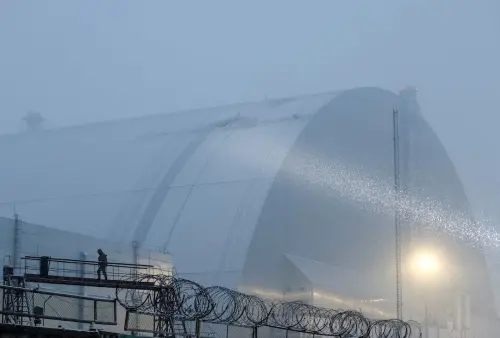KYIV, Feb 14 (Reuters) - The Chornobyl Nuclear Power Plant, where Ukraine accused Russia of a radiation containment structure on Friday, is a decommissioned facility in Ukraine notorious for the world's worst civilian nuclear disaster in April 1986.
Here are some key details about the plant and the tragic event:
The catastrophic explosion that occurred at reactor four on April 26, 1986, resulted from human error by Soviet engineers overseeing the plant.
Contrary to safety protocols, personnel disabled crucial control systems at reactor number four, leading it to an unstable, low-power state, as highlighted in a United Nations report.
A sudden power surge triggered a series of explosions at 1:24 a.m. (2324 GMT), causing the reactor's heavy steel and concrete covering to blow off, releasing a plume of radioactive dust that spread across northern and western Europe, extending as far as the eastern United States.
The explosion from reactor four disseminated vast amounts of radiation, contaminating an area of 150,000 square kilometers spanning Ukraine, Belarus, and Russia, according to the International Atomic Energy Agency (IAEA). A 30-km (19-mile) exclusion zone encircles the site.
The Chernobyl Forum, comprising eight U.N. agencies and the governments of Ukraine, Belarus, and Russia, estimates the death toll from the disaster to be in the thousands. U.N. agencies project a total of around 4,000 fatalities due to radiation exposure.
Greenpeace, an environmental organization, predicts a much higher death toll compared to official figures, anticipating up to 93,000 additional cancer-related deaths worldwide.
Following the 1986 incident, the Soviet Union hastily enclosed the damaged reactor to contain radiation emitted from the substantial uranium remnants.
However, international apprehensions arose in subsequent years regarding the adequacy of the original containment structure.
Bechtel, a U.S. engineering firm, identified numerous deficiencies on its website, stating that significant portions of the sarcophagus were inadequately secured to the primary structure, making the enclosure susceptible to rainwater intrusion, settling, and seismic activity.
Funds were gathered from 45 nations and donor groups to construct the New Safe Confinement, a massive arch made of steel and concrete placed atop the existing Soviet structure.
In December 2000, engineers decommissioned the last operational reactor at Chornobyl, reactor three.
The New Safe Confinement structure was officially finalized and transferred to the Ukrainian government in 2019, with President Volodymyr Zelenskiy present at the handover ceremony.
